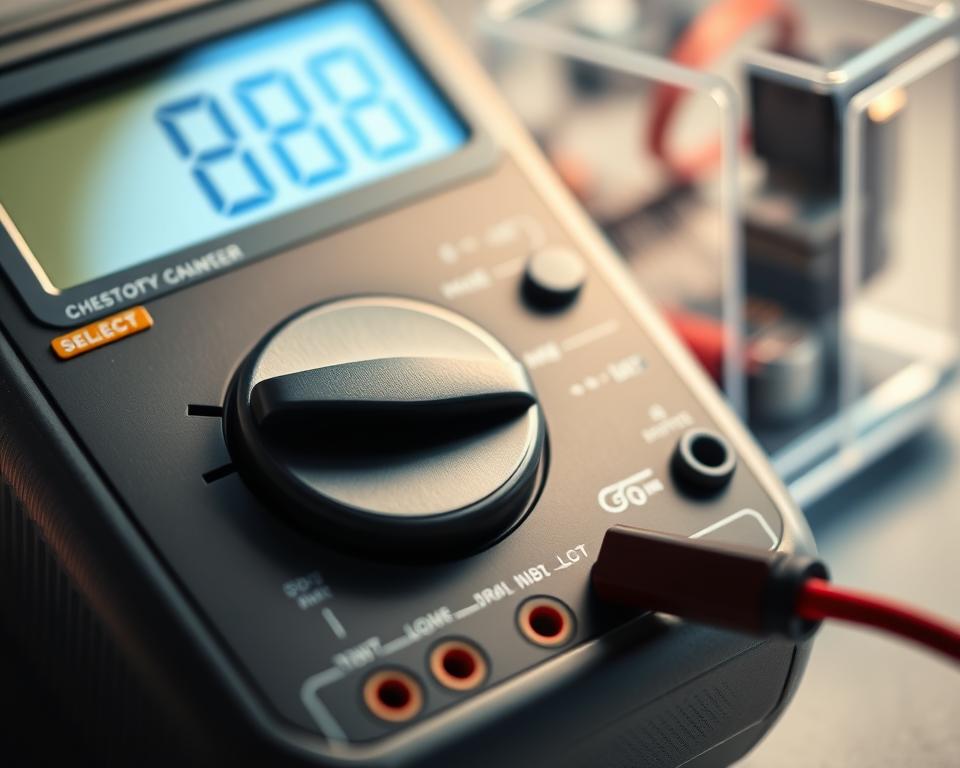Multimeter Applications: Crucial Operations Explained
The standard multimeter can quantify up to 20V in electrical potentials. Yet many initiatives, particularly in invention and tech circuits, use less than 200mA of current. This reality underscores the vital role multimeters play in electronic diagnostics and fault finding. Knowing how to handle a multimeter is crucial, not just for practitioners and specialists, but also for students exploring electrical concepts.
Multimeters are essential in their adaptability, offering accurate measurements of electrical potential, current, and resistance. This write-up will explore the various roles and functions of a Cen-Tech 7 function digital multimeter. It aims to provide you with the knowledge to effectively employ this essential tool in your electronic trials and projects.
Critical Points
- Multimeters are crucial devices for assessing voltage, current, and resistance.
- Understanding multimeter usages is essential for successful troubleshooting.
- Digital multimeters are well-regarded for their transparency and accuracy in measurements.
- Safety precautions are imperative when employing a multimeter for electrical testing.
- Continuity testing is an important function for verifying circuit linkages.
- Selecting the suitable multimeter can substantially influence your testing efficiency.
Overview to Multimeters
A multimeter is vital for diagnosing electrical problems and confirming devices function properly. It assesses multiple electrical parameters, indispensable for both professionals and enthusiasts.
Definition of a Multimeter?
A multimeter integrates devices to assess electrical potential, current, and resistance. This aids considerably in solving circuit problems. Available in traditional and digital versions, multimeters are essential. Analog models use a pointer and scale for gauging, whereas digital ones display values on a display. They test wall outlets, batteries, and various gadgets.
Significance of Multimeter in Electrical Testing
In electrical testing, the role of a multimeter is of utmost importance. It assesses system continuity and identifies problems in multiple contexts. For example, in the auto industry, it evaluates battery potential and sensors. It also guarantees industrial machinery operates smoothly, averting costly breakdowns.
Multimeters, crucial for testing, assess AC and DC voltage, current, and resistance. Their ability to manage diverse tasks makes them invaluable for both straightforward and intricate projects.
Types of Multimeters
Understanding the different types of multimeters is vital for effective electrical testing. They are divided into two key groups: analog and digital multimeters. Each offers distinct attributes and perks. Therefore, choosing the suitable type is determined by your specific demands and preferences.
Traditional Multimeters
Analog multimeters feature a pointer needle and rotary display. They are ideal for observing quickly varying measurements. Their design allows users to see fluctuations as they transpire. Analog devices offer a detection range typically between 1K to 50,000 ohms per volt, with the maximum sensitivity up to 20,000 Ω/V. This established them as popular for broadcast engineers in the mid-20th century.

Digital Multimeters
Due to their accuracy and capability, digital multimeters have evolved into well-regarded. Their LCDs present values clearly and can show up to 4 digits. They can gauge multiple metrics like electrical potential and thermal readings. Furthermore, high-end models feature auto range, recording data, and wireless capabilities. This renders them perfect for advanced tasks in fields like vehicle analysis and renewable energy.
Contrast of Traditional and Digital Multimeters
Choosing between traditional and digital multimeters depends on your specific needs and price range. The table below outlines their primary distinctions:
| Characteristic | Traditional Multimeters | Digital Multimeters |
|---|---|---|
| Display | Dial needle on dial | LCD screen (LCD) |
| Measurement Accuracy | Satisfactory, but less precise | High precision and clarity |
| Latency | Swift response to variations | Depends on sampling rate |
| Applications | Best for rapidly changing values | Adaptive, used in diverse sectors |
| Expense | Typically less expensive | Fluctuates considerably, but can be more expensive |
Although both multimeter types are crucial for electrical testing, digital multimeters’ precision and power have established their popularity among practitioners in both retail and professional spaces.
Elements of a Multimeter
Grasping the primary components of a multimeter is important for its proper use. It consists of various core components, each with a unique role. The visual panel provides measurements, while the function selector enables users to alternate between functions like voltage, current, and resistance. Probes connect the device to the circuit being tested, representing another vital feature.
Key Parts and Their Operations
The primary components of a multimeter are divided into:
- Display Panel: Presents readings in immediate for simple comprehension.
- Selection Knob: Enables users to pick the measurement type, including voltage, current, or resistance functions.
- Connectors: Usually three, but some models have four for connecting different probes.
- Test Probes: Vital for linking the multimeter to electric circuits, with red for positive and the black probe for ground connections.
Understanding Multimeter Probes
Probes serve a critical function in multimeter performance. They are provided in various types, such as standard or alligator clips. The red probe is employed in testing voltage or resistance; the black serves as a ground. Using alligator clips facilitates tasks pertaining to several components, improving measurement accuracy and effectiveness.
Mechanics of the Selection Knob
The selection knob is crucial for maneuvering through the device’s features. By rotating the knob, users can shift between AC and DC voltage readings, current measurement, or resistance testing. Choosing the proper setting is essential for accurate readings. Users must take precautions with the range setting to avert device malfunction or inaccurate results.
Functions of a Multimeter
For anyone involved in electrical testing, understanding the multimeter’s operations is vital. These devices deliver critical readings for accurately evaluating electrical elements. They measure voltage, examine current, and check resistance, making them vital for both professional use and DIY projects.
Measuring AC and DC Voltage
Measuring both AC and DC voltage is a core function of multimeters. They provide remarkable exactness, with the capability to notice minor changes. This is essential for guaranteeing that electrical devices run safely within their specified ranges.
Assessing Current Measurement
Current measurement is more involved than voltage. You must interrupt the circuit flow where you want to determine, as the multimeter integrates into the circuit in series. Choose the proper range, marked in amps or milliamps. Securely attach the multimeter probes between the discontinuities of the circuit.
Understanding Resistance Measurement
Testing component functionality, such as resistors and capacitors, is done through resistance measurement. Multimeters can measure resistance up to a range of megaohms, which is key for examining circuit integrity and executing continuity tests.
Continuity Testing Capabilities
Continuity testing is essential for troubleshooting. It utilizes audio signals or visual signals to signal electrical connections. This secures that circuits operate as designed, facilitating streamlined fault finding.
| Operation | Analog Multimeters | Electronic Multimeters |
|---|---|---|
| Voltage Assessment | Measures AC and DC voltage with remarkable exactness | Evaluating power supply in devices |
| Current Measurement | Assesses flow of electricity in circuits | Checking battery voltage and sensor functionality |
| Resistance Measurement | Tests the operation of circuit components | Ensuring resistors and diodes are within acceptable ranges |
| Continuity Testing | Checks electrical connections | Assessing circuit integrity |
Employing a Multimeter Securely and Efficiently
Understanding how to use a multimeter is essential for anyone working with electrical systems. Proper procedures secure security and measurement accuracy. When gauging voltage, current, or resistance, each step demands certain precautions.
Fundamental Safety Precautions
Acquiring safety precautions before operating a multimeter is vital. Your multimeter should be rated for your operating conditions. Sadly, over thirty percent of electricians use inadequately rated tools, posing hazards. To work securely, always ensure the multimeter is properly configured before attaching probes.
Steps for Measuring Voltage
Measuring voltage necessitates meticulousness. First, choose the correct multimeter range for the voltage, AC or DC. Insert the probes into the right ports: the common and voltage-specific ones. Then, connect the probes correctly to the circuit.
How to Measure Current
Current measurement is more complex than voltage. You must break the circuit path where you want to determine, as the multimeter is connected in series. Choose the appropriate range, marked in amperes or milliamps. Securely attach the multimeter probes between the open points of the circuit.
Steps for Testing Resistance
To accurately test resistance, disconnect the component in question. Switch the multimeter to resistance mode, then connect the probes to the component. A matching reading means that the component works well; otherwise, it might be malfunctioning. This measure mitigates multimeter damage and ensures accurate electrical flow analysis.
Common Applications of Multimeters
Multimeters are vital in both commercial and domestic contexts for a range of tasks. They excel in diagnosing electrical circuits, rendering them priceless. These devices are pivotal in spotting and fixing electrical problems, ensuring systems function properly.
Diagnosing Electrical Issues
Multimeters primarily help in diagnosing electrical circuit issues. Technicians and DIY enthusiasts use them to locate problems. By assessing voltage, current, and resistance, they identify faulty parts, securing safe and efficient operation.
Testing Batteries and Power Sources
Assessing batteries is a crucial application for multimeters. They assess voltage to evaluate automotive or household battery state of charge. This enables users to determine if a battery is in good condition or needs changing, optimizing energy management.
Checking Circuit Integrity
For security and efficiency, assessing circuit integrity is crucial. Multimeters evaluate this by testing continuity and resistance. They spot issues such as broken wires or defects, prompting timely fixes. Overall, multimeters enhance both the safety of installations and circuit troubleshooting.
Choosing the Right Multimeter for Your Demands
Choosing the appropriate multimeter boosts your efficiency in electrical testing. Key factors to consider include accuracy, measurement options, portability, and ease of use. Unlike analog meters, digital multimeters excel in functionality, favored by technicians and hobbyists.
Important Aspects
Essential factors in choosing a multimeter include:
- Accuracy: Digital multimeters provide high precision, sensing variations as small as 1 millivolt.
- Range Options: Choose models that support various electrical metrics like voltage, current, and resistance.
- Portability: Choose compact, easy-to-carry designs for on-site tasks.
- Ease of Use: Auto-ranging and backlit displays enhance a better user experience.
Favored Options: Cen-Tech 7 Function Digital Multimeter
The Cen-Tech 7 Function Digital Multimeter is known for its adaptability and affordability. It integrates key features appealing to both novices and professionals. Additionally, its auto-ranging function simplifies measurements, enhancing task execution.
This model’s measurement range extends to 20,000, ensuring precise readings for a variety of electrical jobs. It excels in troubleshooting, automotive tests, and battery checks. Its mix of noteworthy features and user-friendly design makes the Cen-Tech 7 Function Digital Multimeter a leading choice for a new investment.
Conclusion
Grasping multimeter operations is crucial for those engaged in electrical tasks. We’ve outlined multimeter applications, showcasing their value in testing and safety. Their accuracy in assessing voltage, current, and resistance is irreplaceable. Thus, multimeters are crucial for both practitioners and DIYers.
Multimeters exceed mere assessments. They deliver advanced capabilities like data logging and wireless connections. These features allow for wide-ranging applications, from car diagnostics to harnessing renewable energy. Additionally, capabilities for continuity and frequency checks are instrumental in detecting defects, guaranteeing systems operate seamlessly.
Armed with this understanding, individuals can skillfully employ their multimeter proficiency for detailed diagnostics and boosting protection. They can also boost the efficiency of electrical setups and servicing. Essentially, multimeters’ versatility establishes their indispensability in achieving accuracy in electrical jobs.
Common Inquiries
What are the primary functions of a multimeter?
A multimeter primarily assesses voltage (AC and DC), current, and resistance. It also performs continuity tests. These capabilities are vital for finding electrical problems and verifying electrical continuity.
How do I choose between an analog and a digital multimeter?
Choosing between analog and digital multimeters depends on your preferences. Analog types are excellent at showing rapid value fluctuations. In contrast, digital models provide precise numeric readings. This makes them preferred for daily tasks.
Which safety measures are necessary when operating a multimeter?
When using a multimeter, always select the correct setting before connecting. Refrain from handling live wires when assessing current. Also, disconnect parts before resistance tests to prevent inaccurate readings.
Can a multimeter test batteries?
Yes, battery testing is a frequent application for multimeters. They measure voltage to display charge level. This confirms that your power sources are trustworthy for various needs.
How does continuity testing work, and why is it essential?
Continuity testing checks electrical connections in a circuit using a multimeter. It’s essential for locating faults and restoring connections. This guarantees that your electrical setups operate as intended.
What parts does a multimeter usually consist of?
A multimeter typically includes a reading display, a mode dial, connector jacks, and the probes. The probes interface with the circuit being analyzed.
How does the Cen-Tech 7 Function Digital Multimeter compare to other models?
The Cen-Tech 7 Function Digital Multimeter is simple to operate and delivers flexible features, including auto-ranging. It’s budget-friendly, making it a good choice for experts and DIYers.

